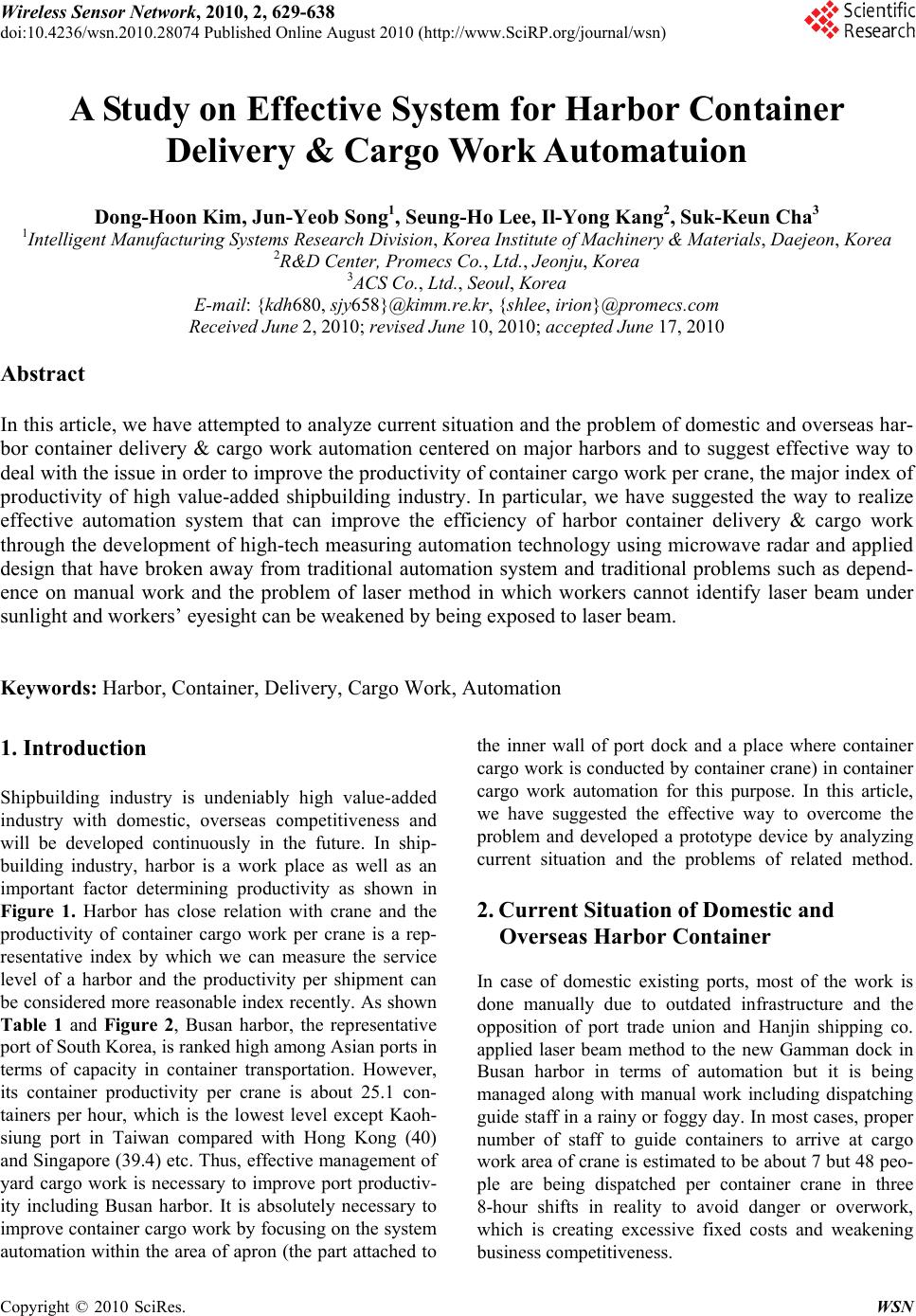
Wireless Sensor Network, 2010, 2, 629-638
doi:10.4236/wsn.2010.28074 Published Online August 2010 (http://www.SciRP.org/journal/wsn)
Copyright © 2010 SciRes. WSN
A Study on Effective System for Harbor Container
Delivery & Cargo Work Automatuion
Dong-Hoon Kim, Jun-Yeob Song1, Seung-Ho Lee, Il-Yong Kang2, Suk-Keun Cha3
1Intelligent Manufacturing Systems Research Division, Korea Institute of Machinery & Materials, Daejeo n, Korea
2R&D Center, Promecs Co., Ltd., Jeonju, Korea
3ACS Co., Ltd., Seoul, Korea
E-mail: {kdh680, sjy658}@kimm.re.kr, {shlee, irion}@promecs.com
Received June 2, 2010; revised June 10, 2010; accepted June 17, 2010
Abstract
In this article, we have attempted to analyze current situation and the problem of domestic and overseas har-
bor container delivery & cargo work automation centered on major harbors and to suggest effective way to
deal with the issue in order to improve the productivity of container cargo work per crane, the major index of
productivity of high value-added shipbuilding industry. In particular, we have suggested the way to realize
effective automation system that can improve the efficiency of harbor container delivery & cargo work
through the development of high-tech measuring automation technology using microwave radar and applied
design that have broken away from traditional automation system and traditional problems such as depend-
ence on manual work and the problem of laser method in which workers cannot identify laser beam under
sunlight and workers’ eyesight can be weakened by being exposed to laser beam.
Keywords: Harbor, Container, Delivery, Cargo Work, Automation
1. Introduction
Shipbuilding industry is undeniably high value-added
industry with domestic, overseas competitiveness and
will be developed continuously in the future. In ship-
building industry, harbor is a work place as well as an
important factor determining productivity as shown in
Figure 1. Harbor has close relation with crane and the
productivity of container cargo work per crane is a rep-
resentative index by which we can measure the service
level of a harbor and the productivity per shipment can
be considered more reasonable index recently. As shown
Table 1 and Figure 2, Busan harbor, the representative
port of South Korea, is ranked high among Asian ports in
terms of capacity in container transportation. However,
its container productivity per crane is about 25.1 con-
tainers per hour, which is the lowest level except Kaoh-
siung port in Taiwan compared with Hong Kong (40)
and Singapore (39.4) etc. Thus, effective management of
yard cargo work is necessary to improve port productiv-
ity including Busan harbor. It is absolutely necessary to
improve container cargo work by focusing on the system
automation within the area of apron (the part attached to
the inner wall of port dock and a place where container
cargo work is conducted by container crane) in container
cargo work automation for this purpose. In this article,
we have suggested the effective way to overcome the
problem and developed a prototype device by analyzing
current situation and the problems of related method.
2. Current Situation of Domestic and
Overseas Harbor Container
In case of domestic existing ports, most of the work is
done manually due to outdated infrastructure and the
opposition of port trade union and Hanjin shipping co.
applied laser beam method to the new Gamman dock in
Busan harbor in terms of automation but it is being
managed along with manual work including dispatching
guide staff in a rainy or foggy day. In most cases, proper
number of staff to guide containers to arrive at cargo
work area of crane is estimated to be abou t 7 but 48 peo-
ple are being dispatched per container crane in three
8-hour shifts in reality to avoid danger or overwork,
which is creating excessive fixed costs and weakening
business competitiveness.